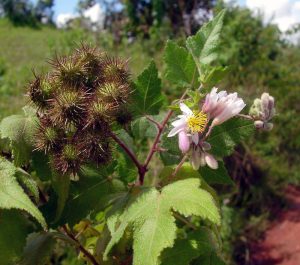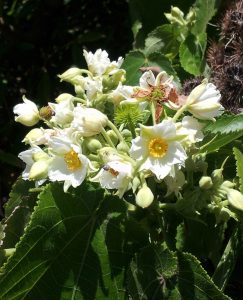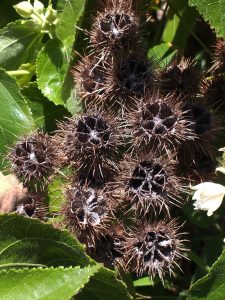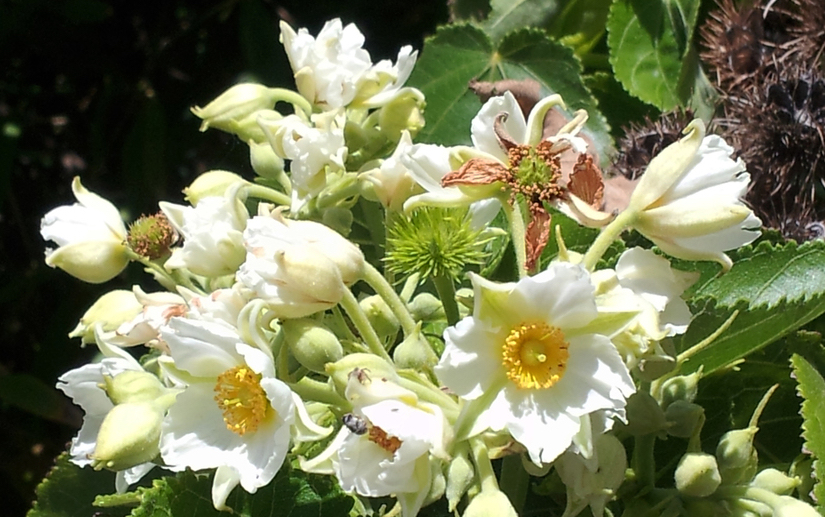As a result of molecular systematics Aotearoa / New Zealand now has very few endemic plant genera left. One of the few remaining endemic genera is Entelea of which whau (E. arborescens) is the sole known species. Whau is easily recognised by the large, soft, vaguely ‘heart-shaped’ leaves; by the clusters of attractive white flowers and spherical spinose fruits (de Lange 2019). Whau is also famous for its light wood reputed be to even lighter and more buoyant than balsa wood (Ochroma pyramidale). The pale-brown wood it produces is also unusual in that it is laid down in bands of unlignified pith-like parenchyma, such that no ‘growth rings’ are formed. Whau was originally placed in the Tiliaceae but molecular systematics and subsequent chemical and morphological research has merged that family with the Malvaceae. Interestingly whau is most closely related to the Afro-Madagascan genus Sparrmannia (Brunken & Muellner 2012; Benor 2018); notably both species have similar growth habits, wood, leaf shape and texture, flowers and fruits (Figure 1.).

Figure 1. Sparrmannia ricinocarpa. Image: Robert van Bittersdorf.
Whau is a common tree around the Auckland Region an abundance appreciated by Māori as can be seen by the names Maungawhau (Mt Eden) and Te Whau (Whau River). The species is indigenous to the Three Kings, North and South Islands, but within that range it is most common in the northern North Island in coastal sites. As a palatable species it is now most frequently seen where introduced browsing animals are uncommon or absent such as on the offshore islands within the Hauraki Gulf and Bay of Plenty, or in places where these animals are controlled. Thankfully whau, as a fast growing and attractive flowering small tree is also widely cultivated, and in Auckland it is a feature of many roadside plantings, especially as part of the ‘roadside restoration vegetation amalgam’ cynically known in the ecological consultancy trade as ‘Transit Scrub’. For an excellent example of this vegetation association look either side of ‘Spaghetti Junction’ next time you traverse inner Auckland.
Modern plantings aside though the apparently natural distribution of whau has intrigued people because the species is (or was) most common from about northern Taranaki and Mahia Peninsula north but south of here it occurs in scattered sites along the Eastern Wairarapa coast, at Cape Palliser, near Paekakariki and around Wellington. The species is also locally common in the coastal scrub and forest of the Golden Bay region of North West Nelson. Whilst some of these southerly North Island locations are undoubtedly the result of recent post European settlement deliberate plantings, Kapiti Island for example, others of longer standing presence are more problematic. Although the disjunction of Entelea to Golden Bay has parallels with the disjunction of kawaka (Libocedrus plumosa), tanekaha (Phyllocladus trichomanoides) the sedge Lepidosperma neozelandicum (Allan 1961; Moore & Edgar 1970) amongst others; the ‘spot’ occurrences in the southern North Island are less easily explained as part of some natural floral disjunction. Consequently, these occurrences along with those noted in the central Waikato and around the Rotorua lakes, have been the source of speculation and debate amongst botanists some of whom have suggested that they stem from deliberate plantings by Māori (Leach & Stowe 2005). Māori are known to have used whau wood, for example Ngati Porou used the wood for floats on nets (Best 1925), while the leaves were used for nappies and sanitary items; the foliage and flowers (Figure 2.) of whau was also used in ceremonies, notably at tangi (Riley 1994). However, these reported usages came from iwi who live within the accepted natural range of the species. Reports of the domestication of whau is therefore speculative and it was for this reason that a DNA based study of whau was initiated in 2009 to see whether whau was domesticated, or at least planted, over some parts of its range by Māori (Shepherd et al. 2019).

Figure 2. Whau flowering material. Image: Peter de Lange.
That study has now been completed and the results published in the New Zealand Journal of Botany (Shepherd et al. 2019). For the research 73 samples spanning the range of whau were analysed using two chloroplast loci (trnS(UGA)–trnfM(CAU) and psbD-trnT(GGU)), the nuclear ITS region and also genotyped nine microsatellite loci.
The study found an unusual pattern; there is an East – West split in the northern range of whau which has hitherto not been noted in other phylogeographic studies of New Zealand coastal plants. The study also found that in the southern part of the species range, in sites where it was suggested whau had been planted that there was a mix of these lineages.
The East – West split within Entelea is estimated to have happened during the Pleistocene. Why this split occurs is problematic, it makes little sense in relation to the current understanding of New Zealand geological or environmental events. While there are as yet no known plant examples duplicating this pattern, the same pattern is evident in far north populations of shore skink (Oligosoma smithii) – though that split is dated to the Pliocene (Hare et al. 2008), and is also seen in kauri snail (Paryphanta busbyi) (a split dated as late Pliocene early Pleistocene) (Spencer et al. 2006). Again, for these animals no sensible explanation has been offered for the splits or the timing of them.
The study found two places where there was a mixing of lineages, the Auckland Region and in the southern range of whau. In the Auckland Region this pattern may be natural. The separation between East and West Coasts here is after all the narrowest in the country. However, it may also reflect that whau has been widely planted in this area over the last forty or so years by local councils, restoration groups and private individuals in Auckland using a range of often unspecified local sources.
The mixing of both lineages in the southern populations of whau is less easily explained. Here the mixing, coupled with the lack of novel genetic variation (chloroplast haplotypes, ITS alleles and microsatellite alleles), does infer that these occurrences could be the result of translocation by Māori. Certainly, it indicates that these populations have not been isolated for sufficient time for novel variation to have evolved, and that they stem from multiple origins. However, the wide distributions of each lineage within northern North Island prevents the identification of the precise sources of these southern populations, which contrasts with studies of other plants now known to have been domesticated and moved by Māori e.g., titirangi (Hebe (Veronica) speciosa) and rengarenga (Arthropodium cirratum) (Armstrong & de Lange 2005; Shepherd et al. 2016; Shepherd et al. 2018). These species have high levels of structuring in their natural populations allowing the origins of the cultivated populations to be determined. Furthermore, the putative translocated populations of rengarenga and titirangi were genetically more similar to more distant populations than the geographically-closest natural populations, supporting their origin through human-mediated dispersal. For whau, the wide distribution of the genetic clusters in the northern part of that species range prevents determination of the source of these southern populations such that at least for now, a natural origin via long dispersal from the northern range of whau cannot be excluded.

Figure 3. Whau spinose fruits. Image: Peter de Lange.
These findings provide rich fodder for future studies of this singular plant. How, for example, is whau dispersed? Past wisdom has assumed that because whau has spinose fruits (Figure 3.) then these must have been dispersed by animals, otherwise why have the spines? Most recently Thorsen et al. (2009) speculated that whau fruits would have been moved by animals, which one assumes in pristine Aotearoa / New Zealand were probably species of moa, yet there is no evidence this happened, and indeed I have not yet seen any of our contemporary large feral animals such as horses, cattle or goats moving whau fruits around. The current genetic evidence doesn’t support animal movement either after all if our extinct moa did move whau, then surely one would expect there to be a mix of genetic lineages rather than the current genetic split because moa were widespread within the northern range of whau, and these birds almost certainly traversed the narrow Northland Peninsula and Te Aupouri isthmus. What I have seen is the fruit cases floating on water, and cast up along beaches and stream sides, and others have reported the fruits as wind-dispersed, noting that in strong breezes the fruits are rolled along beaches, dunes and bare hill slopes. Nevertheless, the way the fruit cases dehisce from top to bottom, and the ‘pepper pot’ way in which the seeds are dispersed well before the fruit cases drop does not support wind or water dispersal either. So, ruling out animal, water or wind dispersal, it would seem that something has contained whau for sufficient time to allow the split to develop. Maybe it is ecological; whau doesn’t thrive in dense forest, it needs regular disturbance and is cold sensitive, so perhaps the interior vegetation of Northland was too dense and conditions too cold to allow it grow there? Currently we don’t know. What we do know is that we have an intriguing pattern that deserves further study. Also, we are left without any clear resolution of whether the current distribution of whau is natural or in part stems from past planting by iwi.
References
Allan, H.H. 1961: Flora of New Zealand. Vol. I. Government Printer, Wellington
Armstrong, T.T.J.; de Lange, P.J. 2005: Conservation genetics of Hebe speciosa (Plantaginaceae) an endangered New Zealand shrub. Botanical Journal of the Linnean Society 149: 229–239.
Benor, S. 2018: Molecular phylogeny of the genus Corchorus (Grewioideae, Malvaceae s.l.) based on nuclear rDNA ITS sequences. The Crop Journal. 6: 552–563.
Best, E. 1925: The Maori Canoe. An account of various types of vessel used by the Maori of New Zealand in former times, with some description of these isles of the Pacific, and a brief account of the peopling of New Zealand. Wellington: AR Shearer.
Brunken, U.; Muellner, A.N. 2012: A new tribal classification of Grewioideae (Malvaceae) based on morphological and molecular phylogenetic evidence. Systematic Botany 37: 699–711.
de Lange. P.J. 2019: Entelea arborescens Fact Sheet (content continuously updated). New Zealand Plant Conservation Network; [accessed 2019 March 4]. http://www.nzpcn.org.nz/flora_details.aspx?ID=1377.
Hare, K.M.; Daugherty, C.H.; Chapple, D.G. 2008: Comparative phylogeography of three skink species (Oligosoma moco, O. smithi, O. suteri; Reptilia: Scincidae) in north eastern New Zealand. Molecular Phylogenetics and Evolution 46: 303–315.
Leach, H.; Stowe, C. 2005: Oceanic arboriculture at the margins – the case of the karaka (Corynocarpus laevigatus) in Aotearoa. Journal of Polynesian Society 114: 7–27.
Moore, L.B.; Edgar, E. 1970: Flora of New Zealand. Vol. II. Government Printer, Wellington
Riley M. 1994: Māori healing and Herbal. Paraparaumu: Viking Sevenseas N.Z. Ltd.
Shepherd, L.D.; de Lange, P.J.; Cox, S.; McLenachan, P.A.; Roskruge, N.R.; Lockhart, P.J.; Kolokotronis, S-O. 2016: Evidence of a string domestication bottleneck in the recent cultivated New Zealand endemic root crop, Arthropodium cirratum (Asparagaceae). PLOS ONE. 11(3):e0152455.
Shepherd, L.D.; Bulgarella, M.; de Lange. P.J.; Chiang, T-Y. 2018: Genetic structuring of the coastal herb Arthropodium cirratum (Asparagaceae) is shaped by low gene flow, hybridization and prehistoric translocation. PLOS ONE. 13(10):e0204943.
Shepherd, L.; Frericks, J.; Biggs, P.; de Lange, P.J. Phylogeography of the endemic New Zealand tree Entelea arborescens (whau; Malvaceae). New Zealand Journal of Botany 57(1): 1–15.
Spencer, H.G.; Brook, F.J.; Kennedy, M. 2006: Phylogeography of Kauri Snails and their allies from Northland, New Zealand (Mollusca: Gastropoda: Rhytididae: Paraphantinae). Molecular Phylogenetics and Evolution 38: 835–842.
Thorsen, M.J.; Dickinson, K.J.M.; Seddon, P.J. 2009: Seed dispersal systems in the New Zealand flora. Perspectives in Plant Ecology, Evolution and Systematics 11: 285–309.
Contact
Associate Professor Peter de Lange
pdelange@unitec.ac.nz

Leave a Reply